Havas reports strong results as it stalks Aegis
Posted in: UncategorizedLONDON – Havas has reported results ahead of expectations with record organic growth, a strong digital performance and revenues up 4.1% to €1.5bn.
LONDON – Havas has reported results ahead of expectations with record organic growth, a strong digital performance and revenues up 4.1% to €1.5bn.
Advertising Agency: Carmichael Lynch, Minneapolis, USA
Chief Creative Officer: Mike Lescarbeau
Executive Creative Director: Jim Nelson
Creative Director: Glen Wachowiak
Senior Writer: Ellie Anderson
Senior Art Director: Brad Harrison
Art Producer: Jenny Barnes
Digital Artist: Unleashed
SINGAPORE – Inchcape-Borneo Motors, the distributor of Toyota and Lexus in Singapore, has replaced Saatchi & Saatchi with Dentsu as its advertising agency for Toyota without a pitch.
Advertising Agency: Leo Burnett, Sao Paulo, Brazil
Creative Director: Ruy Lindenberg
Art Director: Luis Catapano
Photographer: DercÃlio Vanzelli
SEOUL – SK Gas, Korea’s leading petroleum company, has awarded its US$19 million domestic business to TBWA Korea after a five-way pitch.
MANILA – Boehringer Ingelheim, the Germany-based pharmaceuticals giant, is reviewing its 150 million pesos (US$4 million) media business in the Philippines.
Advertising Agency: DDB Nouveau Monde, Toulouse, France
Creative Director: Philippe Domenech
Art Director: Marc Grasset
Copywriter: Jean-Marie Boillot
Photographer: Benoit Guerry – Studio ZE
Published: February 2008
LONDON – HP has kicked off a review of its £15 million pan-European direct marketing account.
LONDON – News International is considering taking The Sunday Times compact, as part of a planned series of major changes to the title.
LONDON – The Government will next week recognise the crucial importance of advertising to the economy as it sets out plans to expand Britain’s creative industries.
LONDON – Engine Group has bought the direct marketing agency Partners Andrews Aldridge and Fuel, its data arm, in a deal worth around £18 million.
Here’s what is labelled an “outdoor campaign” by Duval Guillaume Brussels, I emailed and asked them where this ran because when I first saw the ads I misinterpreted them a little. I even went to Ooops.be to try and get wiser but there’s nothing much on that site to be honest (except a great long list of ad agency clients under references, so I guess this means we need to pass ooops’ spamfilter if we want to contact ad geeks in Belgium!) I blame my misunderstanding on my severe geek streak though, see inside.

Advertising Agency: DDB Nouveau Monde, Toulouse, France
Creative Director: Philippe Domenech
Art Director: Marc Grasset
Copywriter: Jean-Marie Boillot
Photographer: Benoit Guerry – Studio ZE
Published: February 2008
Advertising Agency: DDB Nouveau Monde, Toulouse, France
Creative Director: Philippe Domenech
Art Director: Marc Grasset
Copywriter: Jean-Marie Boillot
Photographer: Benoit Guerry – Studio ZE
Published: February 2008
Rethinking Schools.org has this story about a class of fourth graders who made a difference.
Pink, pink, pink! Everything for girls in this catalog is pink,” exclaimed Kate, one of my fourth graders, as she walked into the classroom one morning, angrily waving the latest “Pottery Barn Kids” catalog in the air.
“I HATE the color pink. This catalog is reinforcing too many stereotypes, Ms. Cooley, and we need to do something about it!”
Advertising Agency: doug agency, Toronto, Canada
Creative Director / Art Director / Illustrator: Ian Schwey
Copywriter: Joe O’Neill
Situation Room, a project / prototype conceptualized and proposed / produced by hackitectura.net, is on view until March 17 at LABoral, an new exhibition, training and production centre for art, science, technology and advanced visual industries located in Gijon, Spain.
Situation rooms are places used in times of crisis to assess and monitor data for decision taking. These rooms are equipped with monitors and data boards to control everything from the Strait of Gibraltar to the nuclear fission processes in a nuclear power station or the life sustaining mechanisms on board the International Space Station. If i tell you that they are also called “control room” then all kinds of images from war, space and spies movies might come to your mind.
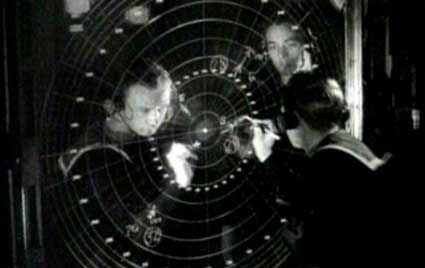
British Destroyer On-Board Glass Polar Plotting Board (via)
With the arrival of the Internet, a more open access to data collection and display technologies has enabled several experiences of Situation Rooms in civil society, with temporary media-labs mainly influenced by cybernetic ideas and free software.
Taking Asturias as a case study, Situation Room invites the public to participate in an open experiment-simulation of a situation room. The second goal of the project is to facilitate the production of common knowledge among artists, geographers, architects, biologists, economists, computer specialists, critics and the public, about the issues put forward.
I found the project so interesting that i asked the coordinator of the project, Pablo de Soto, if he had a few moments to answer my questions. In the meantime i realized that Pablo is a member of hackitectura.net, an activist group of architects, hackers and programmers, whose work i had been admiring for a couple of years. At the core of hackitectura.net are Sergio Moreno and José Pérez de Lama and Pablo. Their collaborative network undertakes practical and theoretical research into the emerging territories of information and communication technologies, new social networks and the traditional physical space.
Answers by both José Pérez de Lama aka Osfa and Pablo from hackitectura:
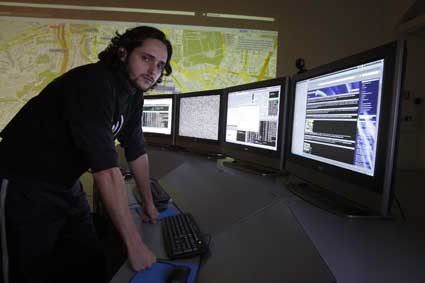
Situation Room. Image LABoral/Cárdenas
I actually discovered your work a few years ago at the festival Mal au Pixel in Paris where you gave a talk about Hackitectura. How does Situation Room builds upon the experience and projects Hackitectura.net have been developing since its creation? How does the project complete (or differs from) your previous works?
The project Situation Room is the distillation of the experiences made by hackitectura.net since 2003 in the design and implementation of several temporary media-labs: “Pure Data Beta Rave” in the abandoned AVE station in Seville, “Okupa Futura: Ciudad Disidente” in the Centro CÃvico Federica Montseny in Corvera de Asturias and “La Multitud conectada”, a media-lab with satellite connection in La Rábida Huelva (2003), Fadaiat: freedom of movement / freedom of communication in both borders of the Strait of Gibraltar (2004 and 2005).
The Multitud Conectada (“Connected Multitude”) was a prototype for a networked public space, produced for a network of activists, artists and technicians. Using technologies such as the bi-directional satellite connection, the wifi (in its infancy at the time) or the streaming with free software, -with real time connections to México, Bogotá or France-, we created a space which was both local and global, digital and analog.
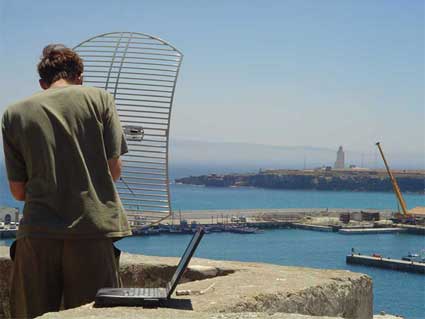
Dave Tarifa Psand pointing grid antenna to Tangier. No GPS device was used. Picture: osfa
In Fadaiat, which we developed in the framework of the Indymedia Estrecho network (an independent production platform and a bi-political production to which hackitectura actively participated), we developed the same concept but focused on the production of a cyborg geography (conception of spaces, social networks and electronic flux), which was located in a geopolitical node as peculiar and antagonistic as the frontier that separates Europe and Africa in the Gibraltar Strait. In Fadaiat, which held editions in 2004 and 2005, we had a distributed medialab, part of it was located in the Castillo de Tarifa (Spain) and the other in the Marshan, in Tánger (Morocco), linked between each other by wifi connection. Besides, this connection, set up by a network of technicians and activists from both parts of the Strait, was the first wifi connection ever made between the two continents, at least the first one managed by hackers and activists. We like to highlight how the link crossed a densely controlled and militarized space, a space with which we were trying to communicate in some way or another.
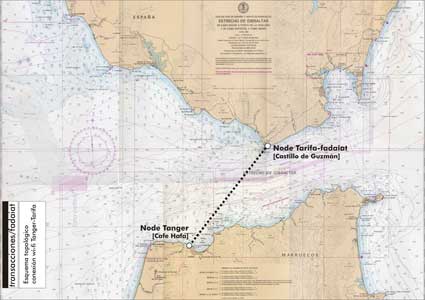
Planning of the wifi link, as sent to ITU Morocco for permission. Image:osfa
The SIVE (Sistema Integrado de Vigilancia Exterior / Integrated System of External Surveillance), which had started to take ground in the area since 2002, constitutes the first attempt to fortify the frontier with electronic tools, and Fadaiat was conceived as a kind of critical mirror to it.
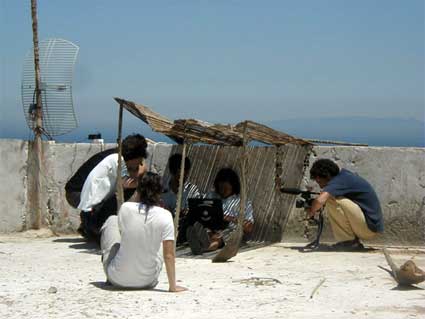
Media-lab Tangier. Daytime, fixing the link with Tarifa. Picture: hd_(((i))) bcn
More specifically Situation Room is the continuation of the temporary laboratory that hackitectura.net designed and implemented in GeografÃas Emergentes (“Emerging Geographies”, 2007), which took place near the nuclear power plant of Valdecaballeros, located in a Spanish region called Siberia Extremeña. Because of the social opposition, the power plant was put to a stop 25 years ago, before it even started functioning and since then it is abandoned, dominating a severe landscape made of steppes, like a post-nuclear ruin.
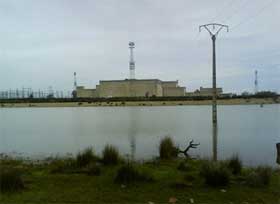
Valdecaballeros nuclear power plant (image)
Taking the challenge of the regional government which called for a development based on knowledge (we are talking about the first region in the world who chose to work with free software at an institutional level) and sustainability, we decided to simulate a takeover of the nuclear plant as a participatory lab in order to initiate a reflexion and come up with proposals regarding the re-use of the power plant in another economical and production context and from other subjects. The laboratory was located in the middle of the field, surrounded by sheep, but it was connected to the internet by a satellite antenna and equipped with computers and screening systems. A geodesic dome acted both as a shelter and as a screen for projections. Made of white textile, it worked from the inside as an immersive interface and from the exterior like a magic lantern in the middle of the night.
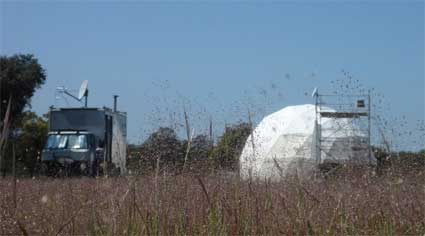
GeografÃas Emergentes, Geolab
The various events that took place in the lab (presentations, debates, workshops, performances) were broadcast live on the net and we also had remote participants via streaming.
An important element of GeografÃas Emergentes was the participation of young people from the area (a competition selected 10 projects to be implemented in the lab) but also of children and adults from Valdecaballeros who participated to workshop and festive events.
Situation Room, an attempt to combine the ideas of a media lab and media room, with practices of data-visualization, cartography and free streaming, aims to present previous experiences in a more artistic and institutional context.
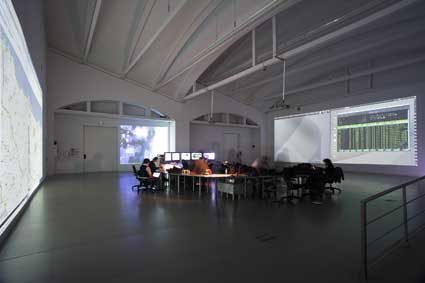
Situation Room. Image Marcos Morilla. Courtesy of LABoral
Which kind of data are you going to monitor during these two months spent in Asturias?
We understand the Situation Room at LABoral, more as a simulation than an actual device to scientifically mine and process data. The main information that we have been showing and discussing at least in the first part of the project, has been the presentation of the concept itself, its origins and proliferating use by command and control powers, and the potentials to hack situation rooms in order to make them perform with other goals.
Situation rooms are on the one hand, devices connected to complex contexts, where processes are non-linear. In order to take decisions and act in these situations, the different agencies (military staff, governments, business, police…) need to continuously monitor reality and establish a permanent feedback loop between it and their actions.
The processing of sets of data extracted from complex systems needs new ways of processing and evaluation, which have to do with cartography and data visualization. On the other hand, situation rooms are only meaningful if we understand them as embedded in networks, which comprise at least two main areas, a sensors area (that captures data) and an actuators area, which allows for strategies and decisions to be performed.
Our ideas where to use Situation Room as a space and time to discuss these issues, and particularly the possibility of turning them into a “multitudinar” device, that is the possibility to use them to empower the action of social networks, rather than central powers. How could situation rooms enhance distributed control. How could they be used to generate socially useful knowledge and to increase coordination between social movements.
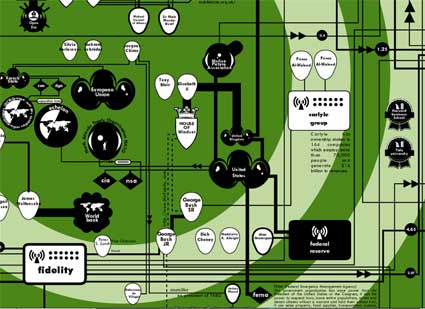
“Financial core,” Bureau d’études, World Monitoring Atlas (via)
One of the questions that we made ourselves is, then, what kind of data would such a situation room be interested in. In order to advance in this direction, we held a workshop with Bureau d’Etudes, the French team famous for their cartographies of capitalism, power and production. It seems somehow that before or beyond quantifying data, a situation room of this sort should produce different images of the system, that would enable other desires and goals. In this workshop we started studying different critical mapping projects, and after that participants – focusing on Asturias, the region where the workshop was happening -, made a list of possible mapping subjects (worked out of the ideas of nodal points, threats and opportunities). This allowed us to produce a preliminary map of the region, somehow a strategic map, that should guide future data mining – and could as well work as a communication and coordination tool.
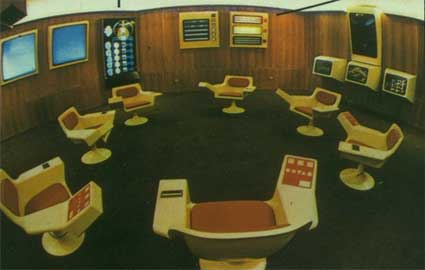
Installation Cibersyn operations room (image)
The second workshop dealt with a project which we feel very closely connected to ours, which is Cybersyn. Cybersyn was a network developed in Chile between 1970 and 1973 under the socialist government of Salvador Allende (Cybersyn was presented in Transmediale, right after Situation Room). A very young team of Chilean techs collaborated with British cybernetics pioneer Stafford Beer to develop a Chile-wide system to coordinate nationalized industries. The aim of the project, however, wasn’t to control factories and workers, but to regulate the network as a living organism, where autonomy of the different cells was compatible with the overall functioning of the organism. Of course, the right wing coup d’etat didn’t allow the project to be completed, but its promises are still of great appeal. One of the interests of this workshop was to realize the social potential of the concept – which astonishingly was designed almost simultaneously to Arpanet itself (1969). Rather than being afraid of control and technologies in general, we think that research and creativity should be applied to the social appropriation of them; we even think that the source of technological creativity, as Cybersyn shows, lies rather on social cooperation, and that is only later captured by the military or capitalism.
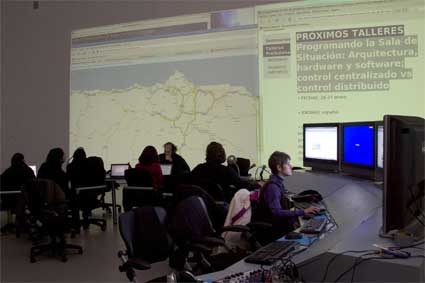
Situation Room. Image Julio Calvo. Courtesy of LABoral
Situation Room is a complex project which includes a series of workshops, a laboratory and the installation itself. What is the aim of the project? What do you hope to explore and learn with it?
We think one of our aims was to advance in the design of situation room that could be actually used in the context of social movements, for special events or for daily research, strategic planning and organizing. Somehow we understand that it should be rather a multiplicity interconnected of situation rooms, embedded in networks of “biopolitical labs” such as social centers and independent media and research groups. As we wrote in the presentation for the project, somehow anyone equipped with tv, Internet, mobile phone and computer, has a personal situation room at home, but we would like to go on researching how the combination of hacktivists medialabs, artists media rooms, multimedia communication, participatory cartography and emergent free software data mining and visualization technologies, could empower social action.
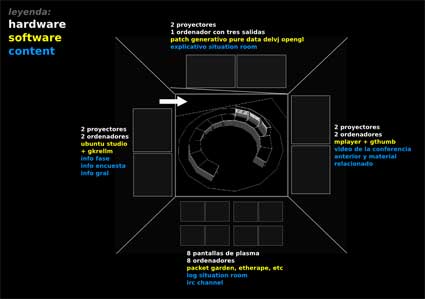
Situation Room, graphic from the first proposal
The presentation of the projects says that the public will be able to participate. How exactly can they get involved in the project?
In the first part of the event, we organized the two already mentioned workshops that were open to the public, and students in particular.
There was a small but intense participation, composed by artists, architects, techies and activists. In the opening sessions we had remote participants, from Barcelona and Malaga, whose images occupied one of the walls of the room. The sessions were streamed through GISS (a global free software network) making them available to anyone connected.
One of the results of the workshops was an interactive cartography of Asturias, based on meipimatic (a wikimapping platform developed by some Madrid friends). In the next weeks, meetings will be held with different local collectives, that are knowledgeable on particular issues such as ecology, labor, urbanism, etc, that we expect to join the mapping team. This groups will be invited as well to set up their temporary offices in the lab and use its resources.
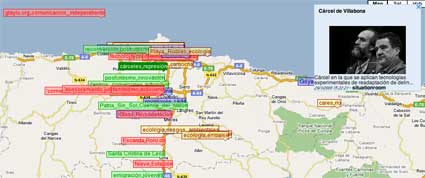
Open tactical cartography of Asturias
The general public is also invited to contribute to the map.
Another way of rather automated participation is through rss feed. Feeds form relevant media, especially independent, are processed and permanently projected in several of the large screens in the lab, presenting a panorama of current issues in Asturias.
Eventually, there will be several workshops with children. Activities will include access to data bases, introduction to data visualization technologies and creation of data bases and maps to be visualized in the Situation Room. Children’s contributions would be incorporated as well to the Asturias meipimatic.
Thanks Pablo and osfa!
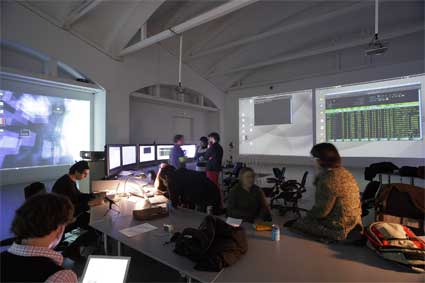
Situation Room. Image Marcos Morilla. Courtesy of LABoral
Situation Room is the winner of the first convocation of the LABjoven Experimenta Contest at LABoral in Gijon, Spain.